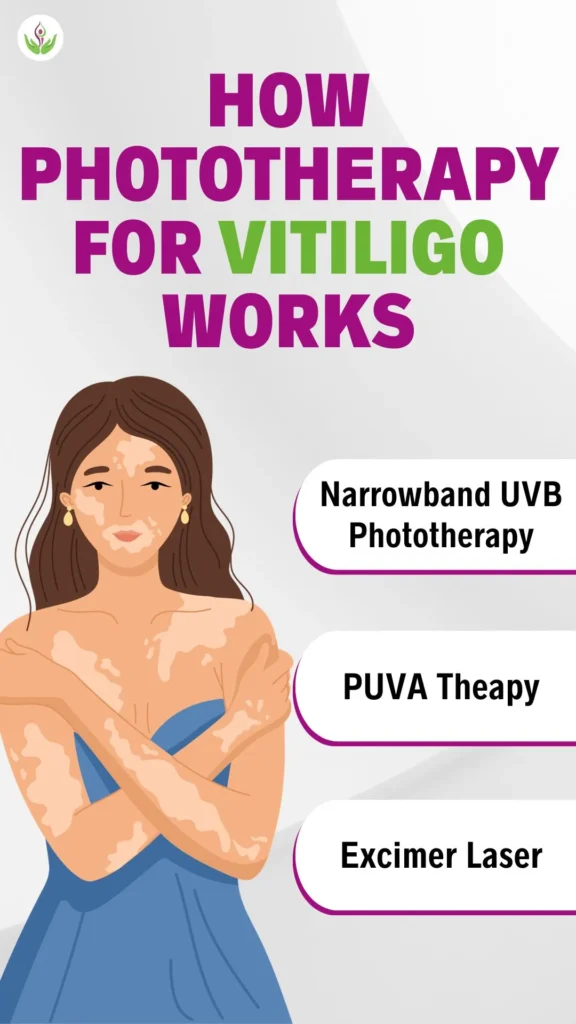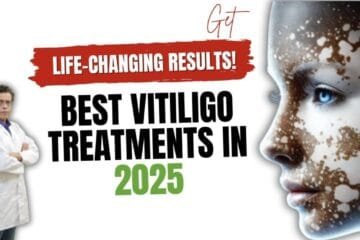Introduction
Vitiligo is a skin condition that makes the skin lose its color. This can have a big effect on a person’s self-esteem and quality of life. But in the past few years, phototherapy has become a ground-breaking treatment choice.
In this article, we’ll learn more about phototherapy for vitiligo. We’ll look at how well it works, what side effects it might have, and some inspiring success stories. Join us on the journey to learn how phototherapy is changing the way people with vitiligo are treated, letting them naturally glow.
Revolutionizing Vitiligo Treatment with Phototherapy
Phototherapy is a new way of treating vitiligo that uses the power of light to get the skin to make more pigment. This method has become very famous because of how well it works, how few side effects it has, and how it can help people get a natural and healthy skin tone. Let’s explore the key aspects of how phototherapy is transforming vitiligo treatment.
Understanding Phototherapy for Vitiligo
Phototherapy, which is also called “light therapy,” includes putting specific bands of ultraviolet (UV) light on the skin that needs treatment. Targeted light exposure makes melanocytes, the cells in the skin that make color, make more melanin. Melanin is what gives our skin, hair, and eyes their colors. In vitiligo, these melanocytes are hurt or killed, which makes the skin white.
Here’s how it works:
- Narrowband UVB Phototherapy: Narrowband UVB (NB-UVB) is a type of phototherapy that is often used to treat vitiligo. It involves exposing the affected skin to UVB light with a narrow wavelength range. This focused contact helps activate the activity of melanocytes and, over time, causes the white spots to get darker again.
- PUVA Therapy: Psoralen plus UVA (PUVA) therapy uses a drug called psoralen, which makes the skin more sensitive to light, along with exposure to UVA light. Phototherapy works better when the skin is more sensitive to UVA light, which is what psoralen does. This method is especially effective for some individuals with vitiligo.
- Excimer Laser: Excimer lasers are another advancement in phototherapy for vitiligo. These lasers send high-intensity UVB light directly to the white spots, which can be very useful in small areas.

Benefits of Phototherapy for Vitiligo
- Effective Repigmentation: Phototherapy, particularly Narrowband UVB and PUVA therapy, has demonstrated significant success in repigmenting white patches caused by vitiligo. These treatments stimulate melanin production, leading to gradual color restoration.
- Non-Invasive: Phototherapy is a non-invasive treatment option. Unlike surgery or other invasive treatments, it doesn’t need cuts or anesthesia. For many people, this makes it a better option.
- Minimal Side Effects: While some individuals may experience mild side effects such as temporary redness, dryness, or itching, phototherapy generally has fewer side effects compared to other vitiligo treatments. These side effects are usually manageable and short-lived.
- Customizable Treatment Plans: Dermatologists can tailor phototherapy treatment plans to suit each patient’s unique needs. The therapy’s intensity, duration, and frequency can be adjusted based on the extent and severity of vitiligo.
- Broad Applicability: Phototherapy can be used to treat regional, segmental, and widespread vitiligo. It is suitable for both adults and children, making it a versatile option for a wide range of patients.
- Improved Quality of Life: Phototherapy that works to pigment the skin often leads to a boost in self-esteem and a better quality of life. Patients may experience increased confidence and reduced emotional distress associated with vitiligo.
- Combination Therapy: Phototherapy can be combined with other vitiligo treatments, such as topical corticosteroids or calcineurin inhibitors, to enhance its effectiveness. This combination approach offers a comprehensive strategy for managing the condition.
- Minimized Risks: Phototherapy, unlike some systemic treatments, focuses on the damaged parts of the skin. This reduces the risk of systemic side effects. This focused approach enhances the safety of patients.
- Long-Term Management: Phototherapy is not a one-time solution but a long-term management strategy. Patients can keep getting treatment as long as they need to keep and improve the results of repigmentation over time.
- Clinically Proven: The effectiveness of phototherapy for vitiligo is supported by clinical research and years of successful patient outcomes. It is a well-established and evidence-based treatment option.

Potential Side Effects of Phototherapy for Vitiligo
Phototherapy is usually thought to be safe and useful, but it can have some side effects. It’s essential for individuals considering this treatment to be aware of these risks.
Common side effects may include:
- Skin Redness: Redness and soreness on the skin that has been treated are normal side effects, but they usually go away after a few hours.
- Dryness and Itching: Some people may feel dryness and burning where they are treated.
- Sunburn: Overexposure to UV light during treatment can lead to sunburn-like symptoms. However, if you adhere to the dermatologist’s recommended treatment plan, you can avoid this.
- Hyperpigmentation: In some cases, hyperpigmentation (darkening of the skin) may occur in the treated areas, but this is usually temporary.
- Eye Protection: During treatment, the eyes need to be protected from UV light by taking steps like wearing masks.

Phototherapy Results
The results of phototherapy for vitiligo can vary from person to person. However many individuals have experienced significant repigmentation and improved skin appearance after undergoing phototherapy treatment.
Here are some key points to consider:
- Success Rates: Studies have shown that NB-UVB phototherapy can achieve repigmentation in approximately 70-80% of treated patients.
- Timeline: Repigmentation is a gradual process and may take several months to become noticeable. Consistency in treatment sessions is crucial.
- Maintenance: To maintain results, ongoing maintenance sessions may be required even after initial repigmentation is achieved.
Conclusion
Phototherapy has emerged as a transformative force in the realm of vitiligo treatment. This light-based treatment not only has amazing benefits before and after, but it also has few side effects, which gives people with this skin problem new hope.
While phototherapy may not guarantee a complete cure for all, it offers a genuine opportunity for individuals to regain their natural skin tone and self-confidence.
With ongoing research and personalized guidance from healthcare professionals, the future of vitiligo treatment shines brightly, promising more individuals the chance to “glow up their natural pigmented skin.










